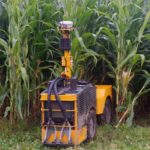A farming robot reduces the need for fertilizer in crops
The robot weaves between the corn rows, applying fertilizer as it goes thanks to GPS.

This summer, Rowbot, a Minnesota startup (USA), began deploying an autonomous robot that rolls between corn plants spraying crop fertilizer.
The robot applies fertilizer while the plant is rapidly growing and needs it most. This eliminates the need for using tractors, which can damage the high stalks, and reduces the amount of fertilizer needed earlier in the season, says Kent Cavender-Bares, CEO of the company. Further, by reducing the fertilizer, the robot reduces the amount of nitrogen that can end up polluting waterways after rainstorms.
As the machine travels between rows, it can spray two rows of corn on either side of the machine. It uses GPS to know when it’s reached the end of the field, and LIDAR, or laser-scanning, to make sure it stays between rows of mature cornstalks without hitting them. Although such fields could also be fertilized at any time via irrigation, only about 15 percent of U.S. cornfields are irrigated.
Rowbot developed its machine under a strategic partnership with Carnegie Robotics, which grew out of research at Carnegie-Mellon University (USA). This summer Rowbot used its machine to fertilize 50 acres of corn, at a charge of $10 per acre (around 7.7 euros) plus the cost of fertilizer.

Technology revolution
Rowbot’s system is part of a technological revolution in farming that has gained momentum in recent years. GPS-guided tractors routinely apply seed and fertilizer across large areas, and new airborne drones are providing farmers with high-resolution sensing ability, although drone services can’t yet be offered commercially in the United States.
Mike Schmitt, a professor in the Department of Soil, Water, and Climate at the University of Minnesota, who has no ties to the startup, says the robot is “a great additional tool to put in the nutrient management technology toolkit.” He says the ability to apply fertilizer at precise times and locations is “very critical."
Rowbot, which is operating on $2.5 million of seed funding (around 1.9 million euros), is in discussions with researchers at the University of Illinois (USA) to conduct studies to prove the advantages of its approach. The next step is to deploy multiple Rowbots on industrial-scale farms, and to add more sensing capacity to the machines. The company is also testing using them for planting seed on cornfields for fall crops, called cover crops, while the mature corn is still standing.